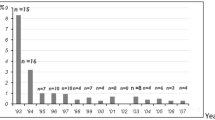Abstract
Purpose
We aimed to compare tacker and suture techniques for peritoneal closure with respect to patient outcomes.
Methods
A total of 64 patients were included in the study, 32 being in the tacker group and 32 in the suture group. All patients underwent laparoscopic TAPP inguinal hernia repair. Both groups were compared with respect to age, sex, duration of peritoneal closure and the operation, hernia type, the number of tackers used for mesh fixation, postoperative complication rate, visual analogue scale (VAS) scores on 1st, 7th, and 30th days, duration of follow-up, and recurrence rates.
Results
Duration of peritoneal closure and the operation was significantly shorter in the tacker group compared to the suture group (p < 0.001, p = 0.008, respectively). Statistical analysis with the two-way analysis of variance method revealed that mesh fixation with one or two tackers did not influence postoperative pain. VAS 1 was significantly lower in patients with peritoneal closure with suture compared to the patients undergoing peritoneal closure with tacker (p = 0.027). VAS 7 and VAS 30 were lower for peritoneal closure with suture versus tacker, although the difference did not reach statistical significance (p = 0.064, p = 0.294, respectively). We observed no recurrence at an average of 21-month follow-up.
Conclusions
Tacker and suture appeared to have a comparable safety for peritoneal closure in laparoscopic TAPP inguinal hernia operation. It can be suggested that peritoneal closure with tacker increased short-term pain, independent of the number of tackers used for mesh fixation. Long-term pain was similar in both groups.


Similar content being viewed by others
References
Bobo Z, Nan W, Qin Q, Tao W, Jianguo L, Xianli H (2014) Meta-analysis of randomized controlled trials comparing Lichtenstein and totally extraperitoneal laparoscopic hernioplasty in treatment of inguinal hernias. J Surg Res 192:409–420. doi:10.1016/j.jss.2014.05.082
Pisanu A, Podda M, Saba A, Porceddu G, Uccheddu A (2015) Meta-analysis and review of prospective randomized trials comparing laparoscopic and Lichtenstein techniques in recurrent inguinal hernia repair. Hernia 19:355–366. doi:10.1007/s10029-014-1281-1
Antoniou SA, Antoniou GA, Bartsch DK, Fendrich V, Koch OO, Pointner R, Granderath FA (2013) Transabdominal preperitoneal versus totally extraperitoneal repair of inguinal hernia: a meta-analysis of randomized studies. Am J Surg 206(245–252):e1. doi:10.1016/j.amjsurg.2012.10.041
Ross SW, Oommen B, Kim M, Walters AL, Augenstein VA, Todd Heniford B (2015) Tacks, staples, or suture: method of peritoneal closure in laparoscopic transabdominal preperitoneal inguinal hernia repair effects early quality of life. Surg Endosc 29:1686–1693. doi:10.1007/s00464-014-3857-3
Bansal VK, Misra MC, Babu D, Victor J, Kumar S, Sagar R, Rajeshwari S, Krishna A, Rewari V (2013) A prospective, randomized comparison of long-term outcomes: chronic groin pain and quality of life following totally extraperitoneal (TEP) and transabdominal preperitoneal (TAPP) laparoscopic inguinal hernia repair. Surg Endosc 27:2373–2382. doi:10.1007/s00464-013-2797-7
Simons MP, Aufenacker T, Bay-Nielsen M et al (2009) European Hernia Society guidelines on the treatment of inguinal hernia in adult patients. Hernia 13:343–403. doi:10.1007/s10029-009-0529-7
Bracale U, Melillo P, Pignata G, Di Salvo E, Rovani M, Merola G, Pecchia L (2012) Which is the best laparoscopic approach for inguinal hernia repair: TEP or TAPP? a systematic review of the literature with a network meta-analysis. Surg Endosc 26:3355–3366. doi:10.1007/s00464-012-2382-5
Tolver MA, Rosenberg J, Juul P, Bisgaard T (2013) Randomized clinical trial of fibrin glue versus tacked fixation in laparoscopic groin hernia repair. Surg Endosc 27:2727–2734. doi:10.1007/s00464-012-2766-6
Wang MG, Tian ML, Zhao XF, Nie YS, Chen J, Shen YM (2013) Effectiveness and safety of n-butyl-2-cyanoacrylate medical adhesive for noninvasive patch fixation in laparoscopic inguinal hernia repair. Surg Endosc 27:3792–3798. doi:10.1007/s00464-013-2970-z
Tolver MA, Strandfelt P, Rosenberg J, Bisgaard T (2013) Female gender is a risk factor for pain, discomfort, and fatigue after laparoscopic groin hernia repair. Hernia 17:321–327. doi:10.1007/s10029-012-0956-8
Tolver MA, Strandfelt P, Forsberg G, Hjørne FP, Rosenberg J, Bisgaard T (2012) Determinants of a short convalescence after laparoscopic transabdominal preperitoneal inguinal hernia repair. Surgery 151:556–563. doi:10.1016/j.surg.2011.08.020
Nienhuijs S, Staal E, Bleichrodt R (2007) Chronic pain after mesh repair of inguinal hernia:a systematic review. Am J Surg 194:394–400
Lau H, Patil NG, Yuen WK, Lee F (2002) Urinary retention following endoscopic totally extraperitoneal inguinal hernioplasty. Surg Endosc 16:1547–1550
Helgstrand F, Rosenberg J, Bisgaard T (2011) Trocar site hernia after laparoscopic surgery: a qualitative systematic review. Hernia 15:113–121. doi:10.1007/s10029-010-0757-x
Van den Heuvel B, Dwars BJ (2013) Repeated laparoscopic treatment of recurrent inguinal hernias after previous posterior repair. Surg Endosc 27:795–800. doi:10.1007/s00464-012-2514-y
Author information
Authors and Affiliations
Corresponding author
Ethics declarations
Conflict of interest
HO declares no conflict of interest, EK declares no conflict of interest, ET declares no conflict of interest and GM declares no conflict of interest.
Rights and permissions
About this article
Cite this article
Oguz, H., Karagulle, E., Turk, E. et al. Comparison of peritoneal closure techniques in laparoscopic transabdominal preperitoneal inguinal hernia repair: a prospective randomized study. Hernia 19, 879–885 (2015). https://doi.org/10.1007/s10029-015-1431-0
Received:
Accepted:
Published:
Issue Date:
DOI: https://doi.org/10.1007/s10029-015-1431-0




